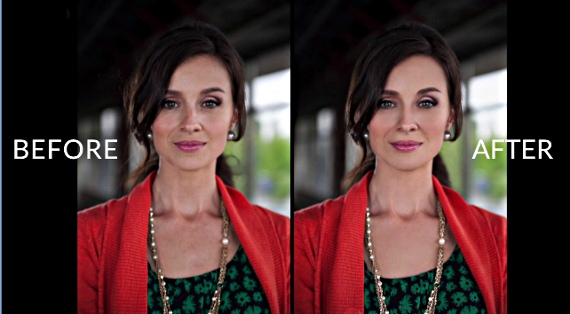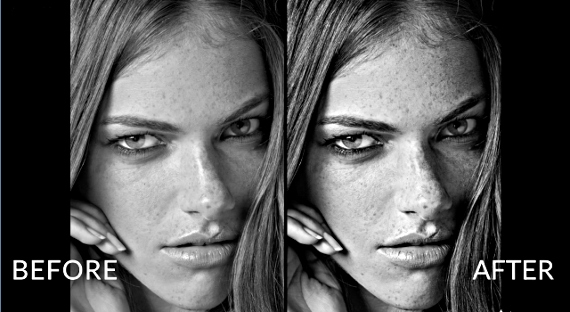There is a fine line between a subtly enhanced photograph and one that has been over “Photoshopped.” Fact of the matter is, we are always trying to find ways in which we can improve our photography and sometimes those ways might include retouching an image. This is especially true when it comes to beauty and fashion spreads. Professional photo retoucher, Pratik Naik is here to share some of his best tips on how to enhance your photographs, all the while maintaining the spirit of the original image. The video is about 45 minutes long and offers great advice from beginning to end, so you may want to grab a piece of paper for some note taking!
“It’s the aesthetics, especially with makeup. If your makeup lines aren’t straight or things like that, many people don’t realize, many make-up artists don’t realize, when they are doing a bad job, but when you get the files back at home and you see all these things you have to fix, you realize what you’re doing isn’t retouching work, it’s actually fixing people’s mistakes.”
Before The Photoshoot:
- Invest in a good make-up artist. A good make-up artist can save you hours of time in post by making sure your model is truly camera ready.
- Make sure that both eyeliner and lip liner is on straight and balanced. Otherwise you will be faced with a lot of tedious Photoshop work of correcting what appears to be crooked features. This is another area where a good make-up will come in handy!
- Very important, always make sure the foundation used on the models face matched the rest of her bodies skin tone!
- If using fake eyelashes and/or mascara, make sure that there is NO visible glue or peeling of the lashes. Also make sure that the mascara isn’t clumping together.
- Before and throughout the shoot, tame any fly aways with a can of hairspray and a brush or comb. Managing fly aways in Photoshop may not be that difficult to do, but it is time consuming and the time spent erasing stray hairs is time you could be spending taking more photos!
Image Retouching In Photoshop
- From the very beginning, know the intended outlet for the image. If it will only be viewed online or in a magazine, chances are it will never be enlarged bigger than a standard size sheet of paper. Keep that in mind when you zoom in extra close and start making corrections to skin tones that will not be seen at such small sizes in the first place–it’s a waste of time! Edit the image at the same size as it will be printed at.
- One of the most common mistakes is over-editing. There is such a thing as too much and as an image retoucher you need to know when you’ve crossed that line. In most cases, less is more.
- When using the dodge and burn tools, set it to a low flow rate so that the changes it makes occurs over a gradual increase instead of getting ultra-dramatic effects instantly. This will help keep you from over doing it.
- Even when the finished product will be in color, make most of your corrections in black and white mode. The reason for this is that having to process all the colors will distract your eye whether you realize it or not.
“You have to remember that they are people, not dolls. You spend all this money on expensive lights and gear and you shoot and everything is sharp and beautiful. Then you go destroy your files by blurring it to death. What’s the point of that? You could have just went and bought a $50 lens. Keep the beauty of it, keep the soul of the file. Don’t destroy the original soul that the file had, that’s what made the file beautiful in the first place. “
For Further Training on Professional Photo Retouching:
There are only a few days left in the discount on Super Photo Editing Skills, a downloadable video tutorial that teaches you how to bring the best out of your images, using Adobe Lightroom. The key to effective professional photo editing is SUBTLE adjustment that brings out the best in a photo. Their course is based on this concept:
The discount can be found here: Super Photo Editing Skills
Like This Article?
Don't Miss The Next One!
Join over 100,000 photographers of all experience levels who receive our free photography tips and articles to stay current:








Great tips! But after watching the video above, I want to see more about your work station and setup. Super jealous!
@Arvind, if you watch the video, Pratik shows how to make corrections in b/w. You can start by desaturating the photo, and making new adjustment layers over it.
@Arvind, ya gotta buy the book. No one writes an article or blog post anymore just for the sheer expression and sharing of techniques… It’s all about selling… Every one has something to sell.
It’s ALWAYS all about the money.
:(
“Even when the finished product will be in color, make most of your corrections in black and white mode. The reason for this is that having to process all the colors will distract your eye whether you realize it or not”
— To the limited levels of my understanding of post processing, I couldn’t figure out how to do a correction in B/W. Could you please share any inputs that you consider would help me take my processing a step further? Would highly appreaciate it.
Thanks much for sharing this article.